The content of the article
- 1 Mention in history
- 2 What should I look for when buying?
- 3 Squid composition
- 4 Valuable properties of squid and the result of their effects on the human body
- 5 Effect on the body during pregnancy and lactation
- 6 Squids in baby food
- 7 Possible harm to the body
- 8 Methods of preparation and recommendations for use
- 9 Video: how to cook squid
Squid is a long-loved product that has increasingly begun to appear in different forms on housewife tables. In addition to valuable taste characteristics, this commercial animal can be attributed to its unique nutrient and biologically active substances. The carcass of a cephalopod is classified as a dietary product. Its composition is rich in protein and has many times less fat than representatives of pond fish.
Availability on store shelves is associated with the feature of squid to grow rapidly and form dense clusters. Their short life cycle and wide distribution in the oceans are capable of satisfying human needs for this tasty and healthy product.
Mention in history
The taste qualities of the mollusk were appreciated by the ancient Greeks and Romans, which is not surprising. It was they who were always famous for their addiction to delicious food and were considered true hedonists. In ancient times, for its quickness and agility, the squid was called "winged fish." From time immemorial, in Asia, seafood is the main product in the diet. And the former Soviet Union began to produce them for food purposes in the sixties of the last century.
Eastern healers have long noticed the effect of potassium on the cardiovascular system through the consumed product. They deservedly considered the mollusk "a balm for the heart."
What should I look for when buying?
The most common for the buyer condition of the carcass and the components of the squid is frozen or chilled. When making your choice, you must consider certain indicators:
- If the carcasses are freshly frozen, then they must be in a free state for each other. It is not allowed to stick together, the formation of layers of hoarfrost, and also a thick layer of ice glaze is not appropriate.
- The natural color of the carcasses can be white, as well as pink and pink-purple. If the product has turned yellow, then this indicates a violation of technological processes during freezing. Repeated freezing and thawing took place. Abnormal color changes may indicate that the mollusk is old and its meat has a rigid structure.
- Damage to the carcass surface is unacceptable. A variety of culinary ideas often requires a solid state of the product without breaks and chips.
- When purchasing packaged goods, pay attention to the integrity of the packaging and labeling.
- If the question is about choosing between large and smaller copies, take into account culinary ideas and features of dishes, but it is important to know that small carcasses have a more pronounced taste of seafood.
- Choosing between cleansed, seductive carcasses and those with which it will take a long and uninteresting mess, a good housewife will choose the latter. Due to the fact that large-scale raw materials are processed in production, chemical compounds are used to remove the film, under the influence of which it is destroyed. Together with the film, squid loses a significant share of useful qualities and taste. The finished product attracts with its ideal surface and the elimination of dirty work, but the taste of the dish may disappoint with the presence of an extraneous taste that has nothing to do with an unprocessed carcass.
Recently, people have become more interested in their health.For many, nutrition has become not just a way to saturate the body, but also an opportunity to enrich it with valuable, nutritious substances that fill the vital energy. Seafood, thanks to its chic composition, has become indispensable for people who are anxious about their health. The wide popularity caused by consumer demand has prompted culinary experts all over the world to study in more detail the recipe and cooking features, the possibility of preserving the beneficial properties of the mollusk.
Squid is an environmentally friendly product that meets all the needs of consumers. What is its value? To understand and apply in the right direction, it has been studied in detail.
Squid composition
Iodine. Its content in edible parts is priceless. This is a source of a useful chemical element for mainland parts remote from the seas and oceans.
- Full-fledged, highly digestible proteins (16.8 - 19, 7%).
- Fats (1 -1, 8%).
- Proteoglycans.
- Glycoproteins.
- Essential Polyunsaturated Fatty Acids.
- Valuable, rare trace elements.
- Zinc.
- Copper.
- Manganese.
- Selenium.
- Phosphorus.
- Minerals (up to 3%).
- Vitamins of group B (B1 - 0, 4 mg / kg; B2 - 1, 17 mg / kg; B3).
- Ascorbic acid.
- Vitamin PP (nicotinic acid).
- Vitamin E.
Carbohydrates (up to 5%). They include the following amino acids:
- leucine;
- glutamic acid;
- aspartic acid;
- lysine;
- alanine;
- arginine;
- glycine;
- isoleucine.
Having undergone any methods of exposure, whether it is drying, smoking, cooking or preservation, the quantitative composition is able to change, calorie content and glycemic index also change.
Valuable properties of squid and the result of their effects on the human body
- Antispasmodic. Riboflavin, present in the composition, is able to reduce the duration of migraine.
- Diuretics The presence of potassium helps relieve swelling, helps to cope with hypertension.
- Hematopoietic. Copper carries out the formation of red blood cells. Holds iron in the body.
- Stimulating. Due to the high iodine content, brain activity and the thyroid gland are activated.
- Firming. Phosphorus improves the condition of teeth and bones.
- Regenerating. Polyunsaturated acids have a positive effect on the liver. Restore with non-alcoholic fat effects.
- Immunomodulatory. Zinc supports the body at a high level. Valuable amino acids are also responsible for resistance to negative external factors.
- Tonic. Increases stamina due to its high protein content. Promotes muscle building.
- Reproducing. Favorably affect the reproduction system. They improve the quality of potency and contribute to facilitating the course of premenstrual syndrome.
- Anti-aging. The squid content of copper prevents the appearance of gray hair and allows you to feel young longer. Vitamin E - guarantees the health and beauty of the skin.
- Modeling and saturating. This is a dietary, easily digestible product that provides the body with useful substances, without being deposited in body fat.
- Restorative. Strengthens blood vessels and heart muscle worn with age, and also improves blood composition. These processes are affected by potassium, cobalt and iron. In terms of potassium content, squid can compete with banana and cereals.
Effect on the body during pregnancy and lactation
Pregnant women are advised to eat squid meat. It will help replenish the body with useful substances and complexes. The cobalt, which is part of the pulp, is involved in the preservation of genetic information, and controls the safety of DNA and RNA.
During lactation, seafood is consumed 6 months after birth. Before diversifying food with this product, there is a need to get a doctor's consultation.
Squids in baby food
In boiled form, the mollusk is well absorbed by the child's body. This is a storehouse of vitamins and minerals, as well as cholesterol and fat in the carcass. For a growing and emerging organism, this is significant support. The positive effect of the mollusk on the nervous system and mental activity has been noticed.
Possible harm to the body
- Squid is an allergen. Excessive consumption of goodies can cause pathological reactions. This is also caused by the introduction of preservatives, flavorings into the finished product.
- Growing in contaminated water bodies and violation in technological processes, violation of storage rules - can be the cause of food poisoning.
- The salt used to dry carcasses and tentacles retains water in the body and can lead to tissue swelling.
Methods of preparation and recommendations for use
It is customary to boil squid meat, fry, dry, preserve and stew. They are stuffed, added to salads and consumed as a self-sufficient dish.
General rules:
- When purchasing a raw product, it must be freed from the skin, if necessary, cleaned inside and remove the chord. For easy cleaning squid pour over boiling water.
- To prepare soft clam meat, it is cooked for 3 minutes. If for some reason the time is extended, then the result will be a rubber consistency of the dish. To remedy the situation, the cooking time is extended to 30 minutes, this helps re-soften the carcass, but the size of the finished squid will decrease.
- It is recommended to store in boiled form for no more than a day. In frozen - 30 days, but this will reduce the value of the product and the brightness of the taste.
According to the advice of nutritionists, squid is included in the diet of fish days. They can replace meat or fish in a dish. The Chinese use dried carcasses as an everyday, light snack. The Japanese decided to have a drink with alcohol, the Slavs drink it with beer. Regardless of preference, squid is a complete food.
The countries of the Far East and Asia are preparing a valuable product in combination with other seafood. Greeks serve it with vegetables, beans and herbs.
Basic recipe
The carcass is lowered into a boiling composition of water, salt, allspice and bay leaf. After 10 seconds, catch a slotted spoon. The output is soft, tender meat. It can be eaten, added to salads.
Video: how to cook squid

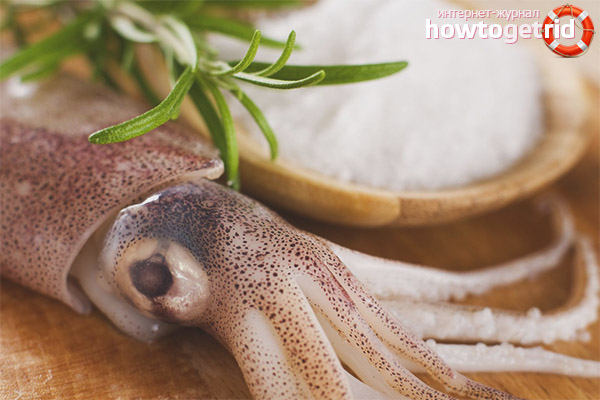
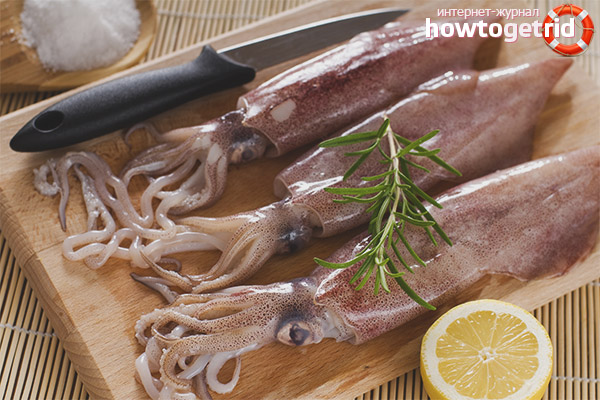
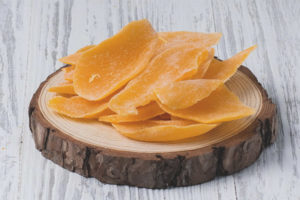
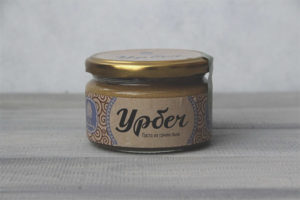
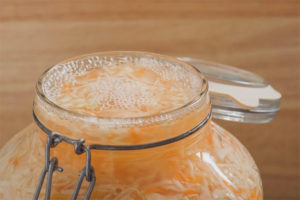

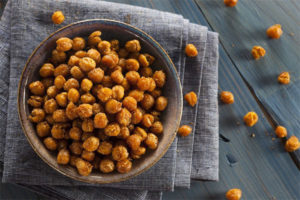

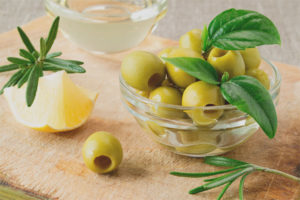

Submit